Comprehensive Marketing Analysis of Coles for HI5004, Holmes Institute
VerifiedAdded on 2023/03/23
|6
|1507
|47
Report
AI Summary
This report provides a comprehensive marketing analysis of Coles, an Australian supermarket chain, examining its company background, marketing orientation (social marketing concept), and product offerings. It delves into the 5Cs (Company, Customers, Collaborators, Competitors, Context) to assess Coles' internal strengths and weaknesses, as well as external opportunities and threats. The analysis covers Coles' competitive landscape, highlighting key competitors like Woolworths and international players, and discusses the impact of legal, environmental, and technological factors on the company's operations. The report concludes with a reference list, providing a thorough overview of Coles' marketing environment and strategic positioning.
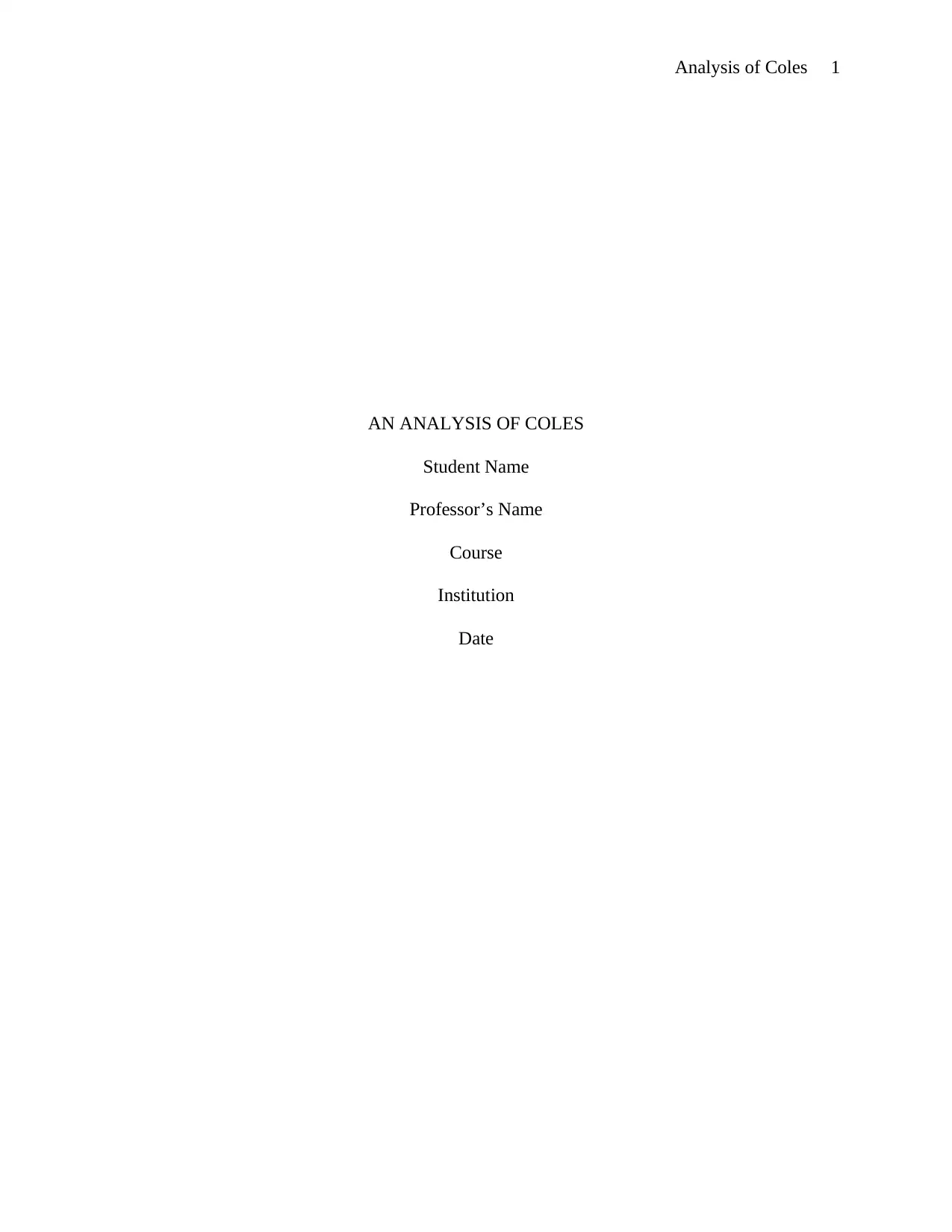
Analysis of Coles 1
AN ANALYSIS OF COLES
Student Name
Professor’s Name
Course
Institution
Date
AN ANALYSIS OF COLES
Student Name
Professor’s Name
Course
Institution
Date
Paraphrase This Document
Need a fresh take? Get an instant paraphrase of this document with our AI Paraphraser
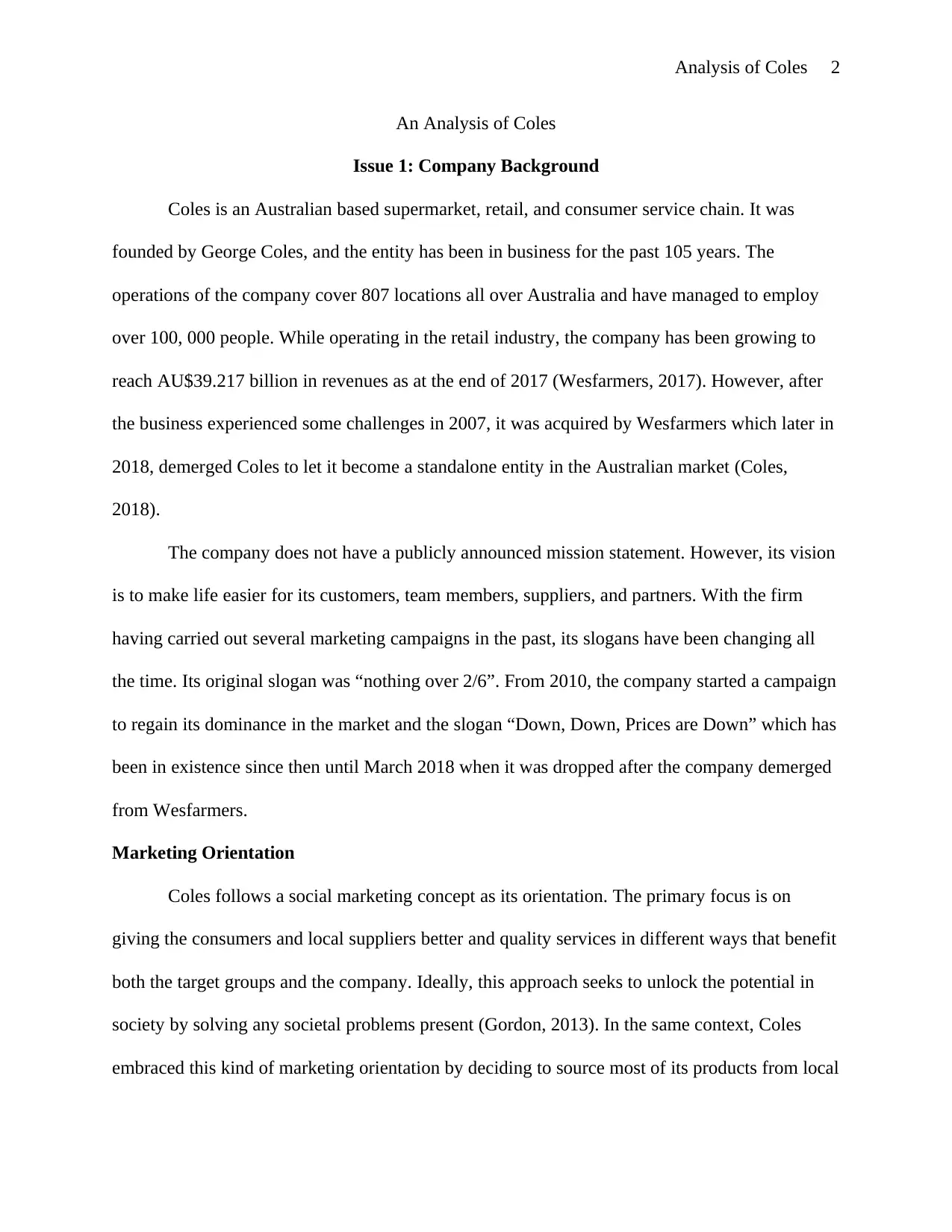
Analysis of Coles 2
An Analysis of Coles
Issue 1: Company Background
Coles is an Australian based supermarket, retail, and consumer service chain. It was
founded by George Coles, and the entity has been in business for the past 105 years. The
operations of the company cover 807 locations all over Australia and have managed to employ
over 100, 000 people. While operating in the retail industry, the company has been growing to
reach AU$39.217 billion in revenues as at the end of 2017 (Wesfarmers, 2017). However, after
the business experienced some challenges in 2007, it was acquired by Wesfarmers which later in
2018, demerged Coles to let it become a standalone entity in the Australian market (Coles,
2018).
The company does not have a publicly announced mission statement. However, its vision
is to make life easier for its customers, team members, suppliers, and partners. With the firm
having carried out several marketing campaigns in the past, its slogans have been changing all
the time. Its original slogan was “nothing over 2/6”. From 2010, the company started a campaign
to regain its dominance in the market and the slogan “Down, Down, Prices are Down” which has
been in existence since then until March 2018 when it was dropped after the company demerged
from Wesfarmers.
Marketing Orientation
Coles follows a social marketing concept as its orientation. The primary focus is on
giving the consumers and local suppliers better and quality services in different ways that benefit
both the target groups and the company. Ideally, this approach seeks to unlock the potential in
society by solving any societal problems present (Gordon, 2013). In the same context, Coles
embraced this kind of marketing orientation by deciding to source most of its products from local
An Analysis of Coles
Issue 1: Company Background
Coles is an Australian based supermarket, retail, and consumer service chain. It was
founded by George Coles, and the entity has been in business for the past 105 years. The
operations of the company cover 807 locations all over Australia and have managed to employ
over 100, 000 people. While operating in the retail industry, the company has been growing to
reach AU$39.217 billion in revenues as at the end of 2017 (Wesfarmers, 2017). However, after
the business experienced some challenges in 2007, it was acquired by Wesfarmers which later in
2018, demerged Coles to let it become a standalone entity in the Australian market (Coles,
2018).
The company does not have a publicly announced mission statement. However, its vision
is to make life easier for its customers, team members, suppliers, and partners. With the firm
having carried out several marketing campaigns in the past, its slogans have been changing all
the time. Its original slogan was “nothing over 2/6”. From 2010, the company started a campaign
to regain its dominance in the market and the slogan “Down, Down, Prices are Down” which has
been in existence since then until March 2018 when it was dropped after the company demerged
from Wesfarmers.
Marketing Orientation
Coles follows a social marketing concept as its orientation. The primary focus is on
giving the consumers and local suppliers better and quality services in different ways that benefit
both the target groups and the company. Ideally, this approach seeks to unlock the potential in
society by solving any societal problems present (Gordon, 2013). In the same context, Coles
embraced this kind of marketing orientation by deciding to source most of its products from local
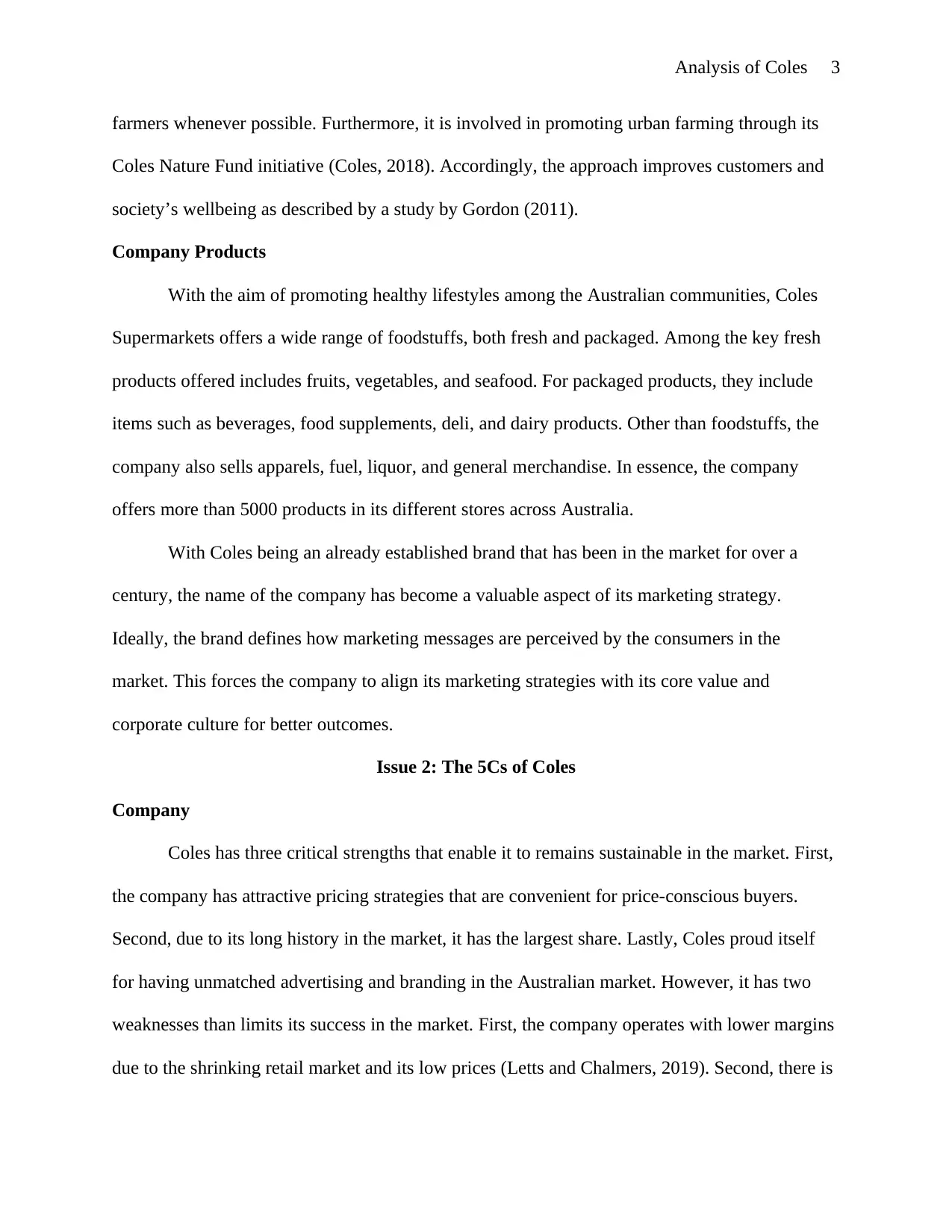
Analysis of Coles 3
farmers whenever possible. Furthermore, it is involved in promoting urban farming through its
Coles Nature Fund initiative (Coles, 2018). Accordingly, the approach improves customers and
society’s wellbeing as described by a study by Gordon (2011).
Company Products
With the aim of promoting healthy lifestyles among the Australian communities, Coles
Supermarkets offers a wide range of foodstuffs, both fresh and packaged. Among the key fresh
products offered includes fruits, vegetables, and seafood. For packaged products, they include
items such as beverages, food supplements, deli, and dairy products. Other than foodstuffs, the
company also sells apparels, fuel, liquor, and general merchandise. In essence, the company
offers more than 5000 products in its different stores across Australia.
With Coles being an already established brand that has been in the market for over a
century, the name of the company has become a valuable aspect of its marketing strategy.
Ideally, the brand defines how marketing messages are perceived by the consumers in the
market. This forces the company to align its marketing strategies with its core value and
corporate culture for better outcomes.
Issue 2: The 5Cs of Coles
Company
Coles has three critical strengths that enable it to remains sustainable in the market. First,
the company has attractive pricing strategies that are convenient for price-conscious buyers.
Second, due to its long history in the market, it has the largest share. Lastly, Coles proud itself
for having unmatched advertising and branding in the Australian market. However, it has two
weaknesses than limits its success in the market. First, the company operates with lower margins
due to the shrinking retail market and its low prices (Letts and Chalmers, 2019). Second, there is
farmers whenever possible. Furthermore, it is involved in promoting urban farming through its
Coles Nature Fund initiative (Coles, 2018). Accordingly, the approach improves customers and
society’s wellbeing as described by a study by Gordon (2011).
Company Products
With the aim of promoting healthy lifestyles among the Australian communities, Coles
Supermarkets offers a wide range of foodstuffs, both fresh and packaged. Among the key fresh
products offered includes fruits, vegetables, and seafood. For packaged products, they include
items such as beverages, food supplements, deli, and dairy products. Other than foodstuffs, the
company also sells apparels, fuel, liquor, and general merchandise. In essence, the company
offers more than 5000 products in its different stores across Australia.
With Coles being an already established brand that has been in the market for over a
century, the name of the company has become a valuable aspect of its marketing strategy.
Ideally, the brand defines how marketing messages are perceived by the consumers in the
market. This forces the company to align its marketing strategies with its core value and
corporate culture for better outcomes.
Issue 2: The 5Cs of Coles
Company
Coles has three critical strengths that enable it to remains sustainable in the market. First,
the company has attractive pricing strategies that are convenient for price-conscious buyers.
Second, due to its long history in the market, it has the largest share. Lastly, Coles proud itself
for having unmatched advertising and branding in the Australian market. However, it has two
weaknesses than limits its success in the market. First, the company operates with lower margins
due to the shrinking retail market and its low prices (Letts and Chalmers, 2019). Second, there is
⊘ This is a preview!⊘
Do you want full access?
Subscribe today to unlock all pages.

Trusted by 1+ million students worldwide
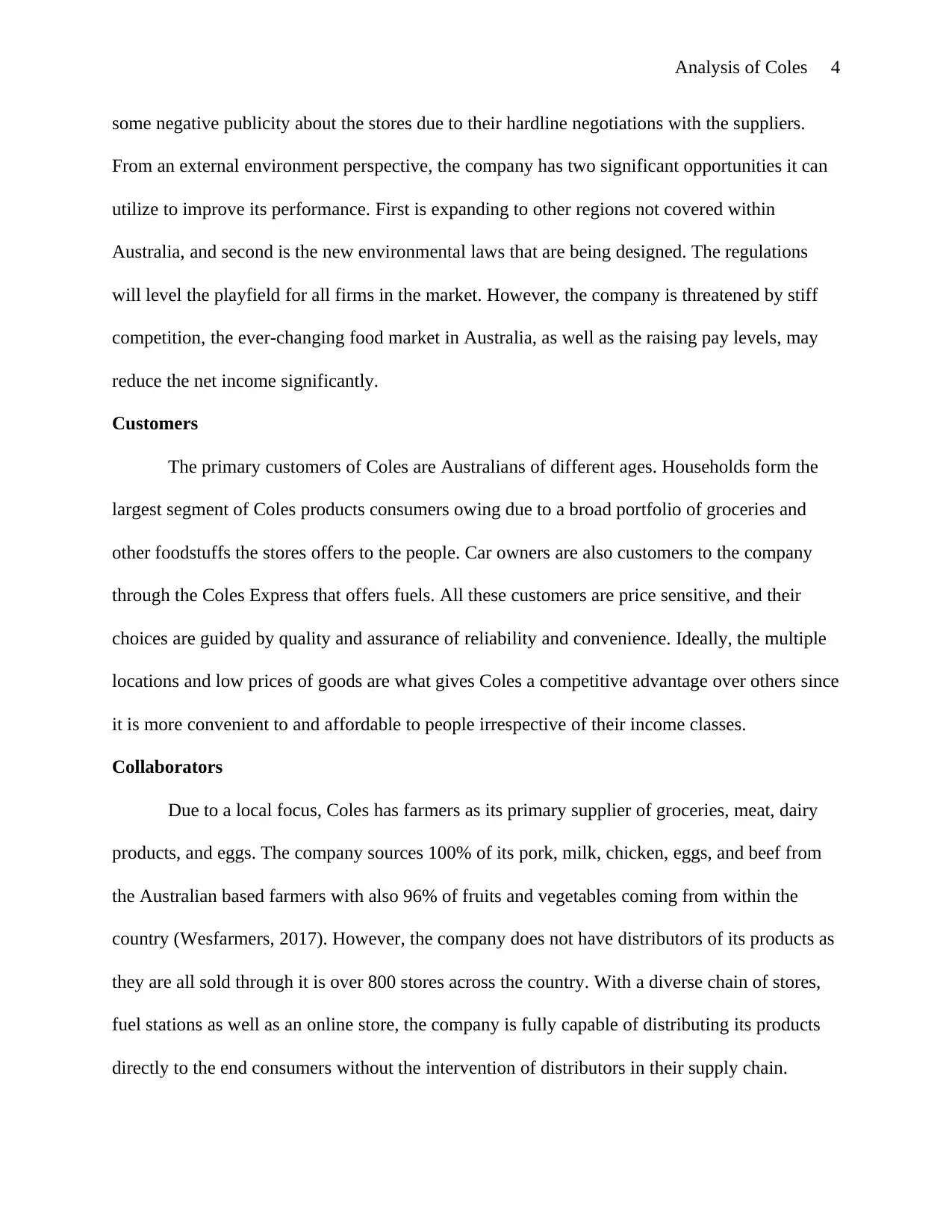
Analysis of Coles 4
some negative publicity about the stores due to their hardline negotiations with the suppliers.
From an external environment perspective, the company has two significant opportunities it can
utilize to improve its performance. First is expanding to other regions not covered within
Australia, and second is the new environmental laws that are being designed. The regulations
will level the playfield for all firms in the market. However, the company is threatened by stiff
competition, the ever-changing food market in Australia, as well as the raising pay levels, may
reduce the net income significantly.
Customers
The primary customers of Coles are Australians of different ages. Households form the
largest segment of Coles products consumers owing due to a broad portfolio of groceries and
other foodstuffs the stores offers to the people. Car owners are also customers to the company
through the Coles Express that offers fuels. All these customers are price sensitive, and their
choices are guided by quality and assurance of reliability and convenience. Ideally, the multiple
locations and low prices of goods are what gives Coles a competitive advantage over others since
it is more convenient to and affordable to people irrespective of their income classes.
Collaborators
Due to a local focus, Coles has farmers as its primary supplier of groceries, meat, dairy
products, and eggs. The company sources 100% of its pork, milk, chicken, eggs, and beef from
the Australian based farmers with also 96% of fruits and vegetables coming from within the
country (Wesfarmers, 2017). However, the company does not have distributors of its products as
they are all sold through it is over 800 stores across the country. With a diverse chain of stores,
fuel stations as well as an online store, the company is fully capable of distributing its products
directly to the end consumers without the intervention of distributors in their supply chain.
some negative publicity about the stores due to their hardline negotiations with the suppliers.
From an external environment perspective, the company has two significant opportunities it can
utilize to improve its performance. First is expanding to other regions not covered within
Australia, and second is the new environmental laws that are being designed. The regulations
will level the playfield for all firms in the market. However, the company is threatened by stiff
competition, the ever-changing food market in Australia, as well as the raising pay levels, may
reduce the net income significantly.
Customers
The primary customers of Coles are Australians of different ages. Households form the
largest segment of Coles products consumers owing due to a broad portfolio of groceries and
other foodstuffs the stores offers to the people. Car owners are also customers to the company
through the Coles Express that offers fuels. All these customers are price sensitive, and their
choices are guided by quality and assurance of reliability and convenience. Ideally, the multiple
locations and low prices of goods are what gives Coles a competitive advantage over others since
it is more convenient to and affordable to people irrespective of their income classes.
Collaborators
Due to a local focus, Coles has farmers as its primary supplier of groceries, meat, dairy
products, and eggs. The company sources 100% of its pork, milk, chicken, eggs, and beef from
the Australian based farmers with also 96% of fruits and vegetables coming from within the
country (Wesfarmers, 2017). However, the company does not have distributors of its products as
they are all sold through it is over 800 stores across the country. With a diverse chain of stores,
fuel stations as well as an online store, the company is fully capable of distributing its products
directly to the end consumers without the intervention of distributors in their supply chain.
Paraphrase This Document
Need a fresh take? Get an instant paraphrase of this document with our AI Paraphraser
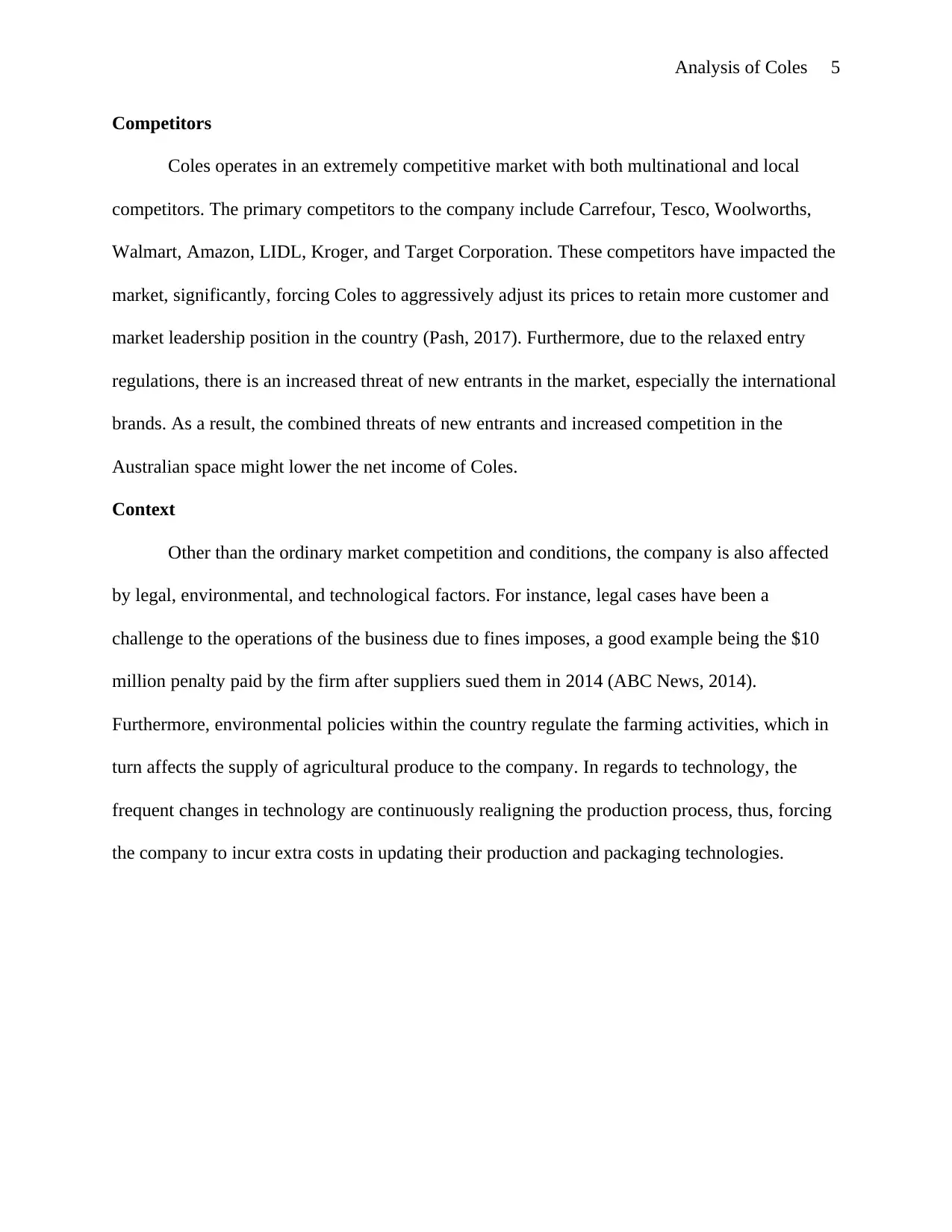
Analysis of Coles 5
Competitors
Coles operates in an extremely competitive market with both multinational and local
competitors. The primary competitors to the company include Carrefour, Tesco, Woolworths,
Walmart, Amazon, LIDL, Kroger, and Target Corporation. These competitors have impacted the
market, significantly, forcing Coles to aggressively adjust its prices to retain more customer and
market leadership position in the country (Pash, 2017). Furthermore, due to the relaxed entry
regulations, there is an increased threat of new entrants in the market, especially the international
brands. As a result, the combined threats of new entrants and increased competition in the
Australian space might lower the net income of Coles.
Context
Other than the ordinary market competition and conditions, the company is also affected
by legal, environmental, and technological factors. For instance, legal cases have been a
challenge to the operations of the business due to fines imposes, a good example being the $10
million penalty paid by the firm after suppliers sued them in 2014 (ABC News, 2014).
Furthermore, environmental policies within the country regulate the farming activities, which in
turn affects the supply of agricultural produce to the company. In regards to technology, the
frequent changes in technology are continuously realigning the production process, thus, forcing
the company to incur extra costs in updating their production and packaging technologies.
Competitors
Coles operates in an extremely competitive market with both multinational and local
competitors. The primary competitors to the company include Carrefour, Tesco, Woolworths,
Walmart, Amazon, LIDL, Kroger, and Target Corporation. These competitors have impacted the
market, significantly, forcing Coles to aggressively adjust its prices to retain more customer and
market leadership position in the country (Pash, 2017). Furthermore, due to the relaxed entry
regulations, there is an increased threat of new entrants in the market, especially the international
brands. As a result, the combined threats of new entrants and increased competition in the
Australian space might lower the net income of Coles.
Context
Other than the ordinary market competition and conditions, the company is also affected
by legal, environmental, and technological factors. For instance, legal cases have been a
challenge to the operations of the business due to fines imposes, a good example being the $10
million penalty paid by the firm after suppliers sued them in 2014 (ABC News, 2014).
Furthermore, environmental policies within the country regulate the farming activities, which in
turn affects the supply of agricultural produce to the company. In regards to technology, the
frequent changes in technology are continuously realigning the production process, thus, forcing
the company to incur extra costs in updating their production and packaging technologies.
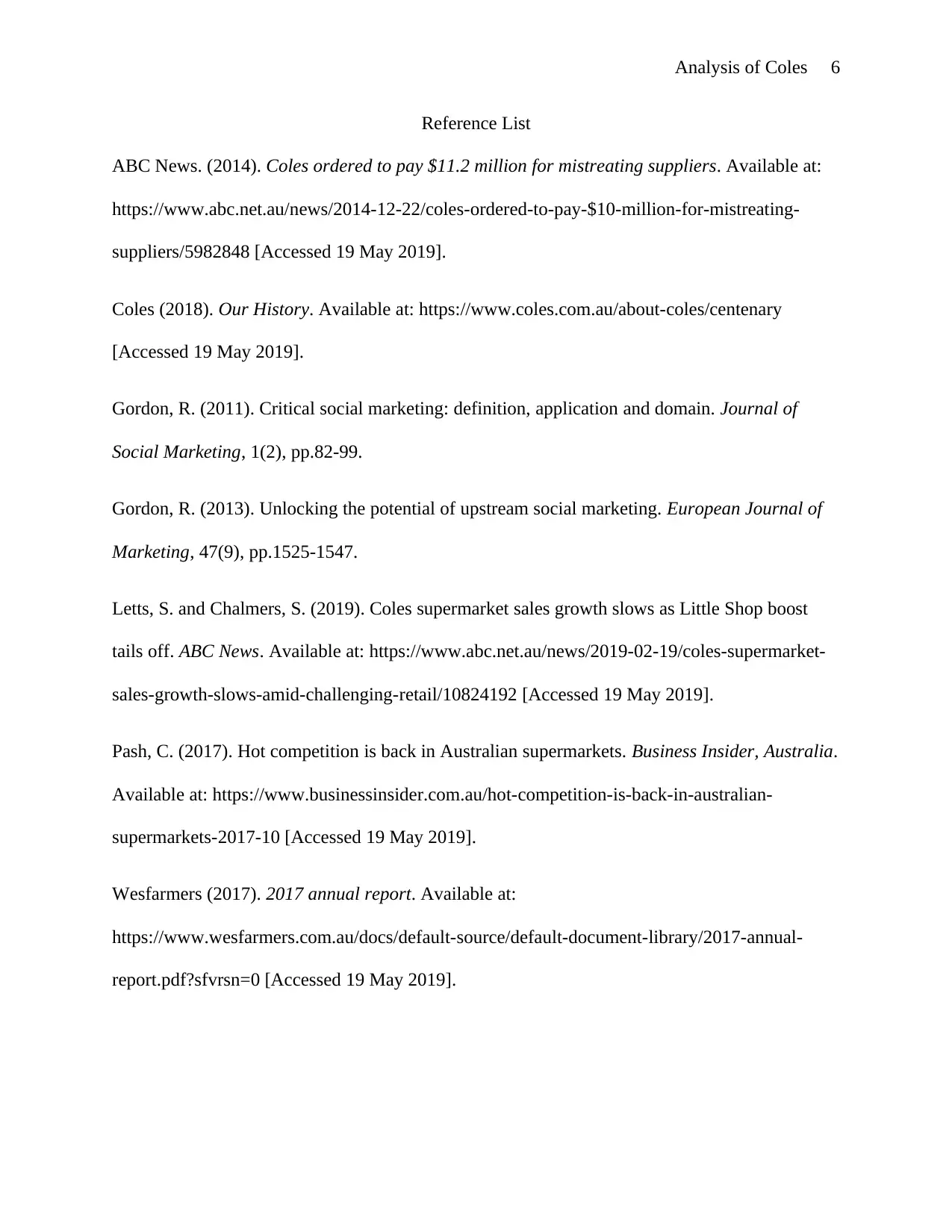
Analysis of Coles 6
Reference List
ABC News. (2014). Coles ordered to pay $11.2 million for mistreating suppliers. Available at:
https://www.abc.net.au/news/2014-12-22/coles-ordered-to-pay-$10-million-for-mistreating-
suppliers/5982848 [Accessed 19 May 2019].
Coles (2018). Our History. Available at: https://www.coles.com.au/about-coles/centenary
[Accessed 19 May 2019].
Gordon, R. (2011). Critical social marketing: definition, application and domain. Journal of
Social Marketing, 1(2), pp.82-99.
Gordon, R. (2013). Unlocking the potential of upstream social marketing. European Journal of
Marketing, 47(9), pp.1525-1547.
Letts, S. and Chalmers, S. (2019). Coles supermarket sales growth slows as Little Shop boost
tails off. ABC News. Available at: https://www.abc.net.au/news/2019-02-19/coles-supermarket-
sales-growth-slows-amid-challenging-retail/10824192 [Accessed 19 May 2019].
Pash, C. (2017). Hot competition is back in Australian supermarkets. Business Insider, Australia.
Available at: https://www.businessinsider.com.au/hot-competition-is-back-in-australian-
supermarkets-2017-10 [Accessed 19 May 2019].
Wesfarmers (2017). 2017 annual report. Available at:
https://www.wesfarmers.com.au/docs/default-source/default-document-library/2017-annual-
report.pdf?sfvrsn=0 [Accessed 19 May 2019].
Reference List
ABC News. (2014). Coles ordered to pay $11.2 million for mistreating suppliers. Available at:
https://www.abc.net.au/news/2014-12-22/coles-ordered-to-pay-$10-million-for-mistreating-
suppliers/5982848 [Accessed 19 May 2019].
Coles (2018). Our History. Available at: https://www.coles.com.au/about-coles/centenary
[Accessed 19 May 2019].
Gordon, R. (2011). Critical social marketing: definition, application and domain. Journal of
Social Marketing, 1(2), pp.82-99.
Gordon, R. (2013). Unlocking the potential of upstream social marketing. European Journal of
Marketing, 47(9), pp.1525-1547.
Letts, S. and Chalmers, S. (2019). Coles supermarket sales growth slows as Little Shop boost
tails off. ABC News. Available at: https://www.abc.net.au/news/2019-02-19/coles-supermarket-
sales-growth-slows-amid-challenging-retail/10824192 [Accessed 19 May 2019].
Pash, C. (2017). Hot competition is back in Australian supermarkets. Business Insider, Australia.
Available at: https://www.businessinsider.com.au/hot-competition-is-back-in-australian-
supermarkets-2017-10 [Accessed 19 May 2019].
Wesfarmers (2017). 2017 annual report. Available at:
https://www.wesfarmers.com.au/docs/default-source/default-document-library/2017-annual-
report.pdf?sfvrsn=0 [Accessed 19 May 2019].
⊘ This is a preview!⊘
Do you want full access?
Subscribe today to unlock all pages.

Trusted by 1+ million students worldwide
1 out of 6
Related Documents
Your All-in-One AI-Powered Toolkit for Academic Success.
+13062052269
info@desklib.com
Available 24*7 on WhatsApp / Email
![[object Object]](/_next/static/media/star-bottom.7253800d.svg)
Unlock your academic potential
Copyright © 2020–2025 A2Z Services. All Rights Reserved. Developed and managed by ZUCOL.





